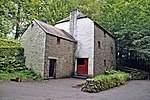St Fagans Old Rectory
Clergy houses in WalesGrade II* listed buildings in CardiffGrade II* listed housesHouses in CardiffReligious buildings and structures completed in 1859 ... and 1 more
St Fagans

St Fagans Old Rectory is a Grade II* listed building in the village of St Fagans in western Cardiff. It is an important Victorian house designed by John Prichard and John Pollard Seddon, built in 1858–9 and used as a rectory until 1975. It is built from coursed squared lies with Bath stone dressings in two storeys and a French medieval-style attic. The steep roofs are made from Welsh slate. A lean-to veranda across the ground floor is supported by stone columns with capitals. The southern bay of the east elevation has a tall truncated pyramidal roof and on the eastern end is a gabled porch.
Excerpt from the Wikipedia article St Fagans Old Rectory (License: CC BY-SA 3.0, Authors, Images).St Fagans Old Rectory
Greenwood Lane, Cardiff St Fagans
Geographical coordinates (GPS) Address Nearby Places Show on map
Geographical coordinates (GPS)
| Latitude | Longitude |
|---|---|
| N 51.4888 ° | E -3.2668 ° |
Address
Greenwood Lane
Greenwood Lane
CF5 6EL Cardiff, St Fagans
Wales, United Kingdom
Open on Google Maps








